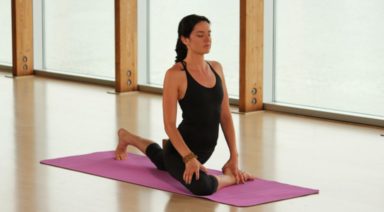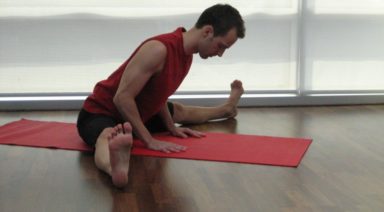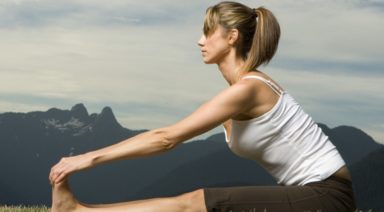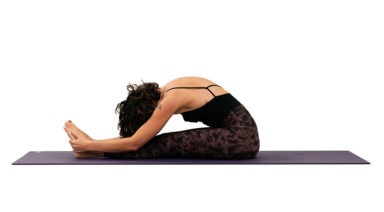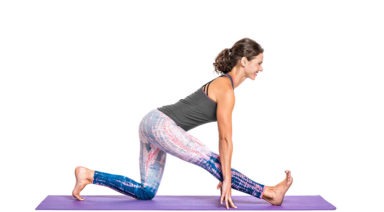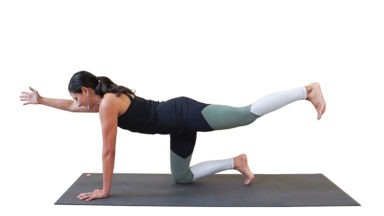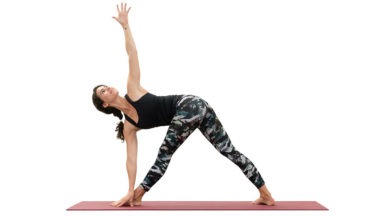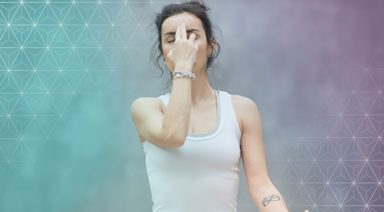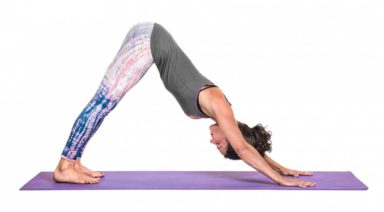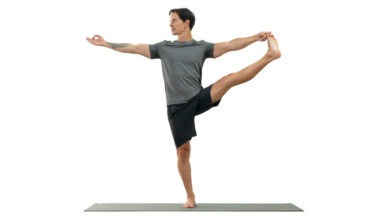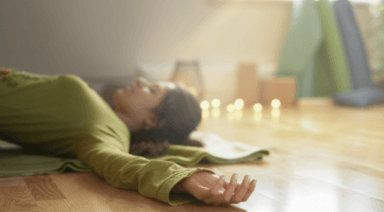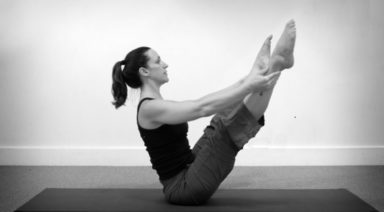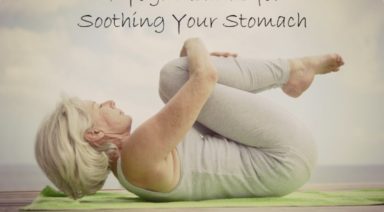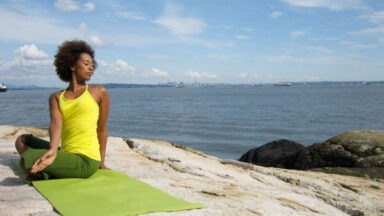3 Exercises to Strengthen Your Hips and Balance Your Body

In yoga we often speak of tight hips, needing to open the hips, balancing the opening of our hips from side to side (etc), but there is more to a balanced body than open hips. We also need stability and support from our hips. This is important not only in yoga but also in day-to-day activities like simply walking. It is especially important if you are an athlete and need to perform on one leg.
A Look Inside the Hip Our hip musculature is made up of many muscles, large and small. For stability, we need the muscles of the side of the hip to be active and engaged. If you place your hands on the sides of your bony pelvis below your waist, you can imagine a tear-drop-shaped area below the ridge of your pelvis. The front part of the tear is the Tensor Fasciae Latae or TFL which connects with your IT band to join at the knee. At the back part of the teardrop are the Gluteus Medius and Minimus, which lie underneath your big Gluteus Maximus.
These muscles are what support and keep you steady in balance poses or when you transfer weight from one leg to the next as you walk or run. For many of us, these muscles are fast asleep, so we recruit our hip flexors at the front or our glutes and our hamstrings at the back to do a job they were not designed to do. Over time this can lead to low back pain and sacroiliac joint pain. Forcing our body to compensate will lead to problems over time. A look outside the hip Tree pose can be a simple test to see if we are accessing our side/lateral hip stabilizers.
Stand in front of the mirror and take a medium-size tree pose with your foot resting on the shin (even if you can go higher). Place your hands on your bony pelvis again and see if they are level from side to side. If not, press the shin into the foot and the foot back into the leg so that the standing hip drops to make the hips level. If this is too difficult to achieve, keep your foot off the ground but come out of tree pose so that your knee is facing forward, raised to hip level with the knee bent.
Try to level the hips again here by firmly rooting into the ground with the standing leg. My Three Favorite Lateral Hip Exercises Most of us can benefit from a little extra love and attention to the side of our hips. Try these exercises to wake up your hips and begin to stand taller on one leg
1. Kick the Ball Standing: Lift one foot off the ground. Keep your leg straight and send your heel forward, toes pointing out as if you were passing a soccer ball in slow motion. Reverse this motion by turning your toes in and sending your leg behind you. Flow forward and back, heel in and out, in a short arc. Don’t forget about your standing leg: root into the earth and don’t let the hip hitch out to the side. Repeat this motion ten times and then switch sides.
2. Clam Shell: Lie on your side with either your arm or a foam block supporting your head. Bend both hips to 90 degrees with knees bent, feet touching, stacked on top of each other. Slowly lift your top knee up towards the sky while keeping your feet together (as if you were a clamshell opening). Keep your hips stacked and avoid rotating with the pelvis. Lower, repeat times, and switch sides.
3. Bicycle: Lie on your side with both legs straight. Flex your feet, as if standing, and stack them on top of each other. Lift your top leg so that feet are hip-width apart. Keep this distance as you flow through this sequence: a) knee bent move forward to the hip at 90 degrees, b) straighten at the knee, c) float straight leg back to start. This should look like you are slowly pedaling a bike. Keep the hips stacked and stable. Strengthening our lateral hips will not only improve our yoga practice, but will also balance our body and prevent injury so that we continue to walk, vinyasa, and run for years to come.
Standing Tall: Why Posture Matters

Remember how your mom used to always lecture you to stand up straight? Well, she might have made some mistakes over the years (that outfit in your 5th grade school picture), but on this one, she’s right. Posture matters more than you may think.
First, let’s talk about your body, starting at the top. Each inch your head is forward of your shoulders doubles the amount of weight it puts on the rest of your body. Although the average head only weighs between 8-10 pounds, your upper back (and then lower back and hips) will become misaligned if your head “lives” in a forward position – all in an attempt to balance your now-too-heavy head.
And, unless you sit in an ergonomically perfect workstation, chances are you round forward over your keyboard or laptop like something straight out of the latest episode of the “Walking Dead.” Most of us, sadly, are in the process of developing this posture. Blame the Internet (we’re talking to you, Mark Zuckerberg) or your boss (for making you work too much).
What happens to our bodies? Back pain, neck pain, hip pain and knee pain. And, let’s not forget your breathing. Collapsing forward compresses your lungs, reducing their capacity by 30 percent or more. Your organs can’t function properly, and neither can your muscles, joints, or connective tissue.
Posture also matters for your mental health. Good posture allows you to breathe more fully, calming your nervous system, which can help with everything from good sleep to good moods. Plus, standing up tall makes you feel more confident. Slouching pulls your energy downward, even making walking and balance more difficult.
What to do? First, analyze your own posture. Do your shoulders slouch? Is your head forward? Do you have back or neck pain? When you walk do you have a tendency to lean forward and feel like you’re lifting your knees towards you?
Since it is vital to have extension in the upper torso in standing posture, the starting place is simply awareness of how you’re standing or sitting. Imagine lifting out of your pelvis, shoulders back, head looking slightly above the horizon.
Don’t spend too much time sitting at your desk, especially in bad posture. Take a walk. Inhale your arms overhead and slightly back. Regularly engage your lower trapezius to draw your shoulders away from your ears, and your rhomboids to draw your shoulders together.
And balance the forward posture with a lot of back bends. Stretch your pecs and anterior shoulder muscles with anahatasana pose (think child’s pose with your hips over your heels, reaching your tailbone and chest away from each other). Camel pose has been called the “antidote to sitting” because it stretches the entire front of your body.
If you have access to a Pilates reformer, you’re in luck. Do seated arm circles to take your shoulders through a weighted stretch, and turn around for chest expansion to, well, expand your chest and your lung capacity. Or just lie down on a mat, extending arms and legs long on the floor, and lift up, fluttering arms and legs in opposition while breathing deeply.
Most importantly, throughout your day, remember to stand up straight. Don’t slouch. Just listen to mom on this one. You can still argue about your clothes, your politics, and what’s for dinner. On posture, she’s right.




